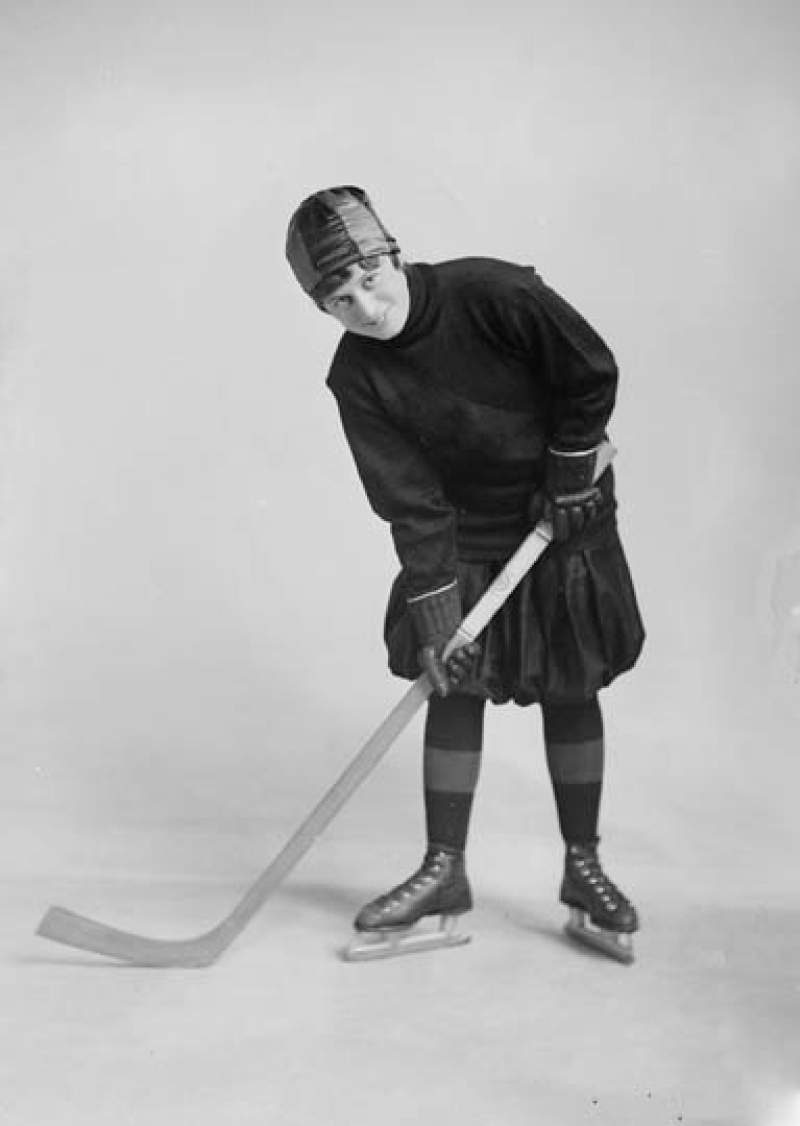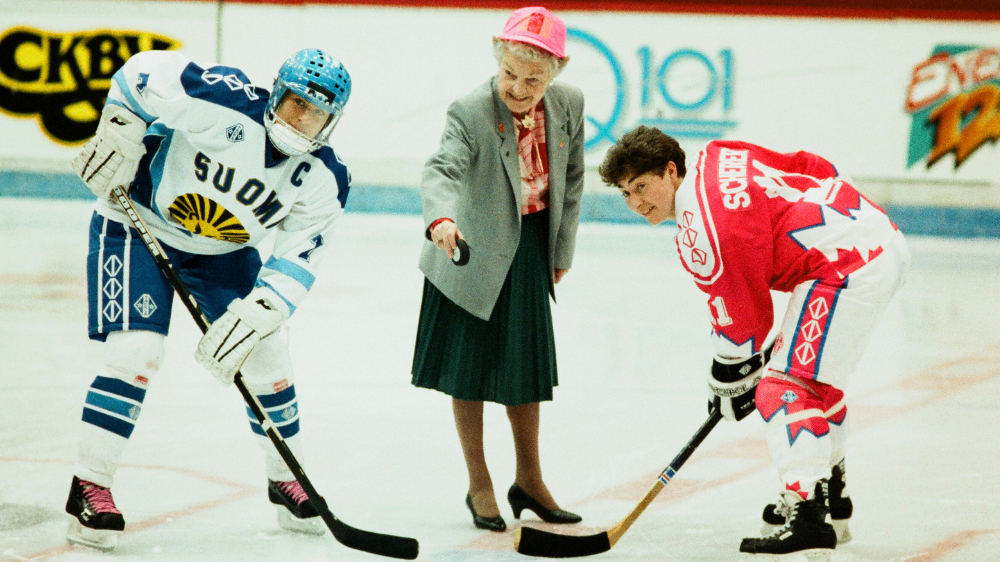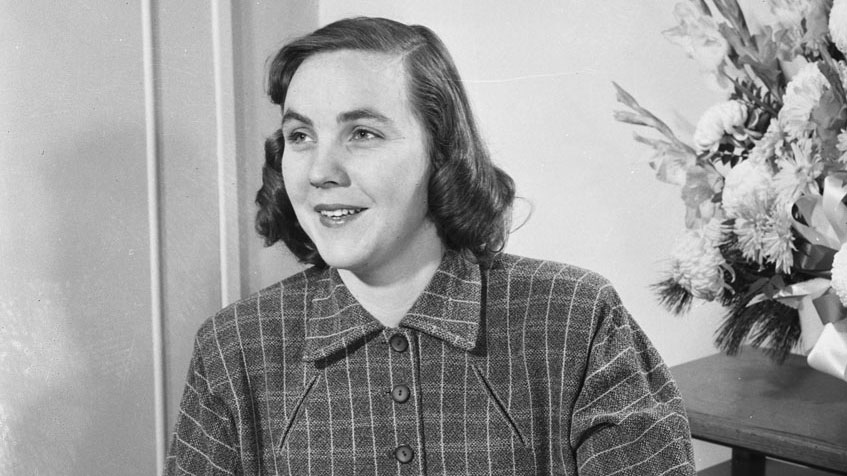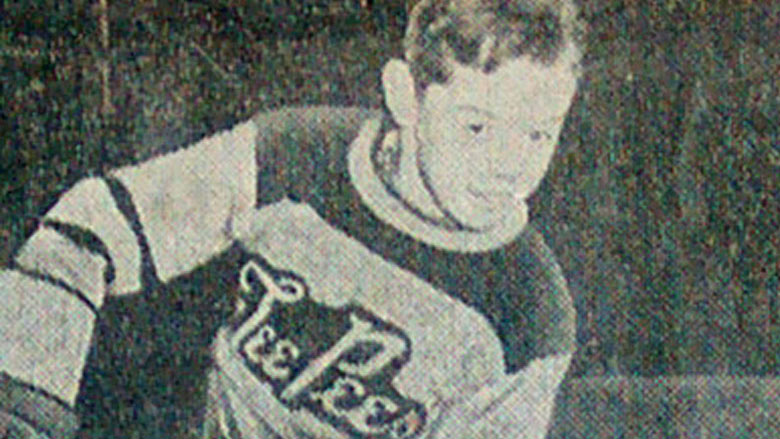Early Trailblazers

Portrait of the “Queen of Ice” Eva Ault.

Hazel McCallion drops the puck at the first IIHF Ice Hockey Women's World Championship in 1990. Credit: Claus Anderson

Elizabeth Graham (centre with high gloves) was one of the first known goalies to don a mask.

Hilda Ranscombe poses for a Rivulettes team photo.

Portrait of Marguerite Norris in her office.

Photo of Abby Hoffman from a newspaper article about her story.
Lady Isobel Stanley
Isobel Stanley, the daughter of Canada's Governor General, Lord Stanley of Preston, began to play ice hockey after being inspired by the game played at the Montreal Winter Carnival in 1889. As a pioneer of the game in Canada, Isobel helped to popularize ice hockey.
Eva Ault
Ault began her playing career during the years of the First World War, joining the Ottawa Alerts in 1915. The consistent goal scorer was popularly known as the “Queen of the Ice.”

Portrait of the “Queen of the Ice” Eva Ault.
Albertine Lapensée
Lapensée began playing for the Cornwall Victorias at 16 years old. From 1915 to 1918, the Victorias never lost a game with Lapensée in the lineup. Lapensée would regularly score a half‐dozen goals a single game, with a career‐high of 15 in a 21‐0 victory. She was nicknamed “The Miracle Maid.”
Hazel McCallion
Widely known as the former mayor of Mississauga, Ontario, Hazel McCallion began playing hockey in the late 1920s in Port Daniel on the Gaspé coast of Quebec. With her two older sisters playing defence, Hazel took her spot as a lightning‐quick centre on a team in a ladies' league. After moving to Montreal, McCallion turned 'professional,' earning $5 a game to play for Kik Cola, one of three teams in a ladies' league there, making her one of the first paid female players documented.
Upon being elected mayor in 1978, Hazel McCallion spread her influence into other hockey‐related areas, including sitting on the board of the Ontario Women's Hockey Association (OWHA), obtaining ice time for girls' hockey and also grew hockey by bringing international tournaments and the men's Ontario Hockey League to Mississauga. McCallion was honoured in 1987 by the OWHA as they named the trophy for the first Women's World Championship (unsanctioned by the IIHF) the Hazel McCallion World Cup.

Hazel McCallion drops the puck at the first IIHF Ice Hockey Women's World Championship in 1990. Credit: Claus Anderson
Bobbie Rosenfeld
At a time when interest in women's sports was germinating, Bobbie Rosenfeld was already dominating, not just in hockey (her favourite team sport), but in lacrosse, basketball, softball, tennis and track & field. In fact, Fanny 'Bobbie' Rosenfeld's sporting exploits were so extraordinary during the 1920s and thirties that she was named Canada's Female Athlete of the First Half‐Century (1900‐1950). Rosenfeld was born in Austria in 1904, but moved to Barrie, Ontario as a child and by her early twenties, had starred as a centre on the 1927 and '29 Ontario champion Toronto Patterson Pats of the North Toronto Ladies' City League. A newspaper during that era called Rosenfeld the “superwoman of ladies' hockey.” In 1924, Bobbie helped inaugurate the Ladies' Ontario Hockey Association (LOHA). She represented Canada in track & field at the 1928 Olympics, winning a gold medal in the 4x100 relay and a silver in the 100 yard dash. After retiring, Bobbie Rosenfeld wrote a daily column on women's sports for the Globe and Mail.
Elizabeth Graham
Queen's University (Kingston, Ontario) netminder Elizabeth Graham is often credited with being one of the first goaltenders, and likely the first female netminder, to wear a mask for protection. The historic event took place on February 7, 1927, three years before NHLer Clint Benedict strapped on his leather mask. As reported in the Montreal Daily Star at the time, Graham “gave the fans a surprise when she stepped into the nets and then donned a fencing mask.” It seems likely that Elizabeth's father pressured her into wearing the mask after she underwent extensive dental work.

Elizabeth Graham (centre with high gloves) was one of the first known goalies to don a mask.
Hilda Ranscombe
Throughout the 1930s, Ranscombe led her Ladies Ontario Hockey Association team, the Preston Rivulettes (a baseball team that formed a hockey team), to 345 victories out of 350 games as well as six Dominion championships until WWII ended their dynasty. Possessed with dazzling speed, she was considered by many the equal of most boy players, some of whom went on to play in the NHL as men. Her fame enabled the women's league to flourish in Ontario and for women's hockey to grow in popularity across the country.

Hilda Ranscombe poses for a Rivulettes team photo.
Marguerite Norris
In 1952, Norris was named president of the Detroit Red Wings after her father's passing, making her the first woman to hold the title of president of an NHL team, even to this day. Norris presided over three full seasons, all of which the Red Wings finished first in the league and even won two Stanley Cup championships in 1954 and 1955. The 1952 win made Marguerite the first woman to have her name on the Cup.

Portrait of Marguerite Norris in her office.
Abby Hoffman
In 1956, nine‐year‐old Abby Hoffman wanted to play hockey, but there were no girls' leagues. She registered in the local Toronto league under the name Ab Hoffman. Later selected from 400 participants to join the Toronto Hockey League All‐Star Team, Ab was released when her birth certificate was presented, exposing the fact she was a girl to the league. Her family took the unjust dismissal case all the way to the Ontario Supreme Court, but even with support from the media, public and NHL teams, the league's boys‐only policy remained. Later in her life, Abby would represent Canada at four Olympic Summer Games in Athletics.

Photo of Abby Hoffman from a newspaper article about her story.